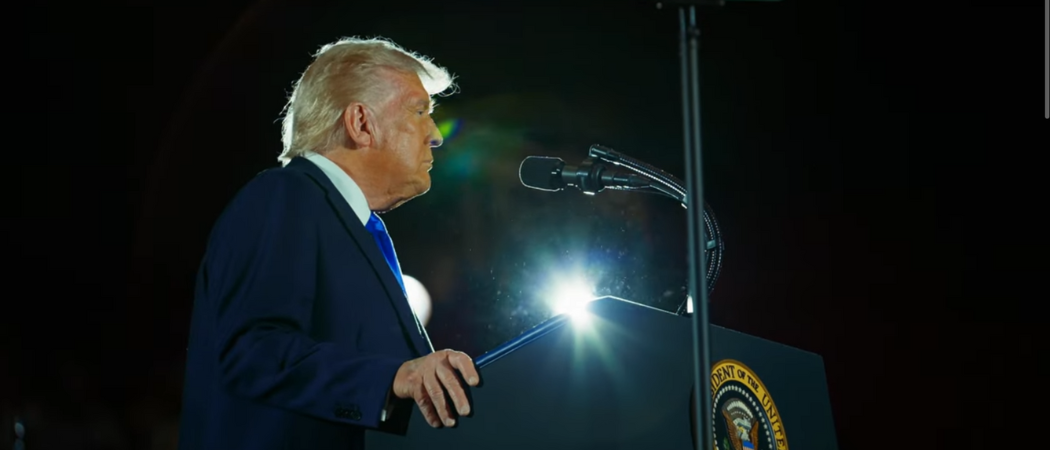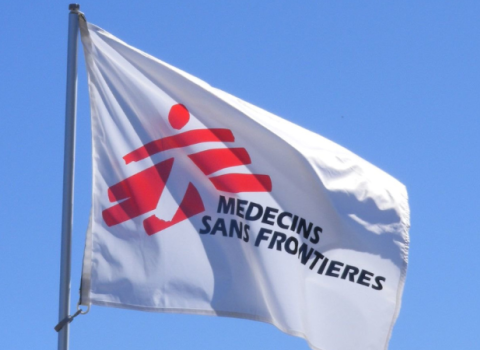Dramatic policy change will disrupt clinical trials, and coincides with massive new budget cuts for 2026

US President Donald J. Trump’s commencement address at the University of Alabama. Photo credits: The White House / YouTube
Stepping up its America-first campaign, the Trump administration has started to cut funding for medical-research projects that involve foreign labs. The move will disrupt clinical trials for new medicines now underway, critics warned.
In a statement issued on May 1, the US National Institutes of Health (NIH) said it is immediately halting most new grant awards to foreign partners working in US-led research consortia. It cited “national security” reasons, and appeared to reflect Trump claims, still hotly disputed, that COVID-19 was a leak from a Chinese lab to which the NIH had been providing some funding.
The NIH is the world’s largest funder of biomedical research. While the vast majority of its budget gets spent in the US, since 1 October 2024 it has also supported about 1,500 so-called foreign sub-awards to international research partners, according to the US government’s central funding database, usaspending.gov. Among the biggest recipients have been institutes and universities in Canada, Haiti, South Africa, Kenya, the UK, Germany, Belgium and France.
The new policy, first reported in Nature magazine, came amid a new volley of Trump assaults on the US academic and scientific establishments. On May 2, the White House published a summary of its 2026 budget plans, including a 40% cut in NIH spending, and a 55% cut in the National Science Foundation (NSF) budget. On the same day, the NSF announced it is copying a policy rolled out last month at NIH: cutting how much American universities can charge for lab space and other “indirect” costs of research.
‘Harmful’ policy
Not surprisingly, there was a loud reaction in Washington. “Catastrophic,” was what the American Association for the Advancement of Science called the budget plan. “Harmful, anti-science,” said the Union of Concerned Scientists. The NSF policy “will mean fewer scientific innovations and breakthroughs,” said the American Association of Universities.
The whole package – cuts and policy changes – will hurt US institutions and halt many international partnerships, warned the National Council of University Research Administrators. Said the association’s director, Kathleen Larmett: “These cuts go far beyond a balance sheet: they represent real setbacks in biomedical innovation, public health preparedness and the education of future scientific leaders.”
The actions are part of Trump’s campaign against institutions and programmes he considers “woke,” wasteful or un-American. For instance, the draft budget accused the NIH of having “broken the trust of the American people with wasteful spending, misleading information, risky research and the promotion of dangerous ideologies.”
Last month, as part of an attack on America’s elite Ivy League universities, he singled out Harvard University for $2.2 billion in grant suspensions, and made threats – repeated over the past weekend in his social media feed – to yank the university’s tax-exempt status. Harvard is suing to stop him.
Many of these threatened changes, such as the NIH indirect-cost policy, are now tied up in court. And nobody expects the 2026 budget proposal to get through Congress unaltered. But NIH’s new foreign-partner policy is the first broad change that would directly hurt US scientific partners around the world. Aside from cuts to specific international aid projects and doctoral mobility grants, the global scientific community has mostly watched in shock.
Related articles:
- US set to close office responsible for global science and technology deals
- NIH turmoil risks reciprocal EU-US access to health research funding
How foreign subawards work
Generally, under longstanding NIH policy, a “prime” grant recipient such as a US university or research institute may pass smaller portions of its grant to research partners at home and abroad with special expertise or resources. For these “subawards” the agreement is between the prime and subawardees, rather than NIH itself. But the prime recipient is supposed to inform the NIH, monitor the partners’ work, and ensure security and other conditions are met.
For instance, Princeton University is currently running a research project with assistance from Germany’s Helmholtz Centre for Infection Research and Cornell University’s Weill Medical College. The aim: to learn how the hepatitis C virus can jump across species, posing new human health risks. Princton runs the project, with a $6 million NIH grant, according to the US government database. Of that, Helmholtz has received $1.03 million since October 1.
Another Helmholtz lab has received $100,000 since October 1 under a long-running $25.6 million NIH grant for the University of California-Davis to maintain the US’s largest database of mouse mutations for medical research. And in Paris, the Pasteur Institute received $419,000 to help a multi-centre project led by the University of California to search for new COVID treatments, according to the government database.
But such arrangements, which are not limited to medical grants, don’t fit with Trump’s America-first ideology; he has repeatedly said he wants American discoveries to bring money and jobs to the US, rather than be shared with foreigners. In March the General Accountability Office, at the behest of a Republican-controlled Senate committee, documented widespread under-reporting and inadequate monitoring of subawardees, domestic and foreign. In one sample of 96 subawards it studied, more than half – totalling over $130 million – hadn’t been correctly reported. The study, however, was of energy, transportation and other grants that didn’t involve NIH, and even among the funders that it did study, only one had its comments included in the report.
The new policy
The May 1 NIH statement says that, effective immediately, it will not renew or fund any new, foreign sub-awards of $30,000 or more until it gets a new contracting system operating. This is scheduled to happen by September 30. That system, it said, will “prohibit subawards from being nested under the parent grant.” Instead, new awards will need separate contracts with NIH directly, so they’re easier to vet and monitor. It added that it won’t alter existing grant arrangements “at this time,” and won’t apply the policy to purchases of “unique” foreign lab supplies or consulting services.
At the very least, these changes will add piles of paperwork and legal issues for foreign grantees, said Cole Donovan, associate director of the Federation of American Scientists and a former Biden White House aide. “For an administration trying to roll back regulations, this doesn’t feel like it,” he said.
That’s ironic, he said, given how the US had long complained to Brussels that its Horizon Europe programme had too much paperwork and hazard for US researchers joining an EU project. He added that, if the Trump NIH were really worried about national security, it could simply classify rather than halt research it deems problematic.
And though billed as temporary, many in Washington expect the restrictions to continue throughout Trump’s term. A leaked staff memo, by a top NIH official, declared flatly that “subawards to foreign sites can’t continue.” According to Science magazine, which first reported it publicly, the memo stated: “If you can’t clearly justify why you are doing something overseas, as in it can’t possibly be done anywhere else and it benefits the American people, then the project should be closed down.”
In response to Science|Business questions, NIH sent a press statement that: “Foreign components (of grants) can still be funded—but they must be structured as independent subprojects rather than subawards. NIH cannot currently track foreign subawards with accuracy—a serious problem that has been highlighted in GAO reports, raised by Congress, and identified as a national security risk. The data are inconsistent across internal systems and public databases. This lack of visibility is unacceptable and is exactly why radical change is needed.” If a clinical trial is affected by the new policy, the statement said, “NIH will provide funds for safe and orderly shutdowns at foreign sites”, maintain patient safety and privacy, and allow investigators to “reapply for future awards with subject structures.”
Draconian budget cuts
Beyond the NIH, much of the noise over the weekend in Washington concerned the 2026 budget proposal. The White House “skinny” budget, which is an executive summary to be followed by a full submission to Congress, listed massive cuts in research funding across the government, combined with incendiary rhetoric against the science establishment. This would come on top of a near-freeze on government-wide R&D funding, at $193 billion, for the current fiscal year ending September 30.
For instance, the 2026 plan proposes a $1.15 billion cut to the Energy Department’s science programmes “for climate science and Green New Scam research.” Instead, money will go to supercomputing, artificial intelligence, quantum computing and critical minerals.
Likewise, it proposes a $260 million cut for similar “Green New Scam” research at the Advanced Research Projects Agency-Energy, and $1.31 billion in “climate-dominated” research at the National Oceanographic and Atmospheric Administration. On the campaign trail, Trump repeatedly called climate change a “Chinese hoax.”
A $4.7 billion, or 55%, cut to the NSF budget would end research “with dubious public value, like speculative impacts from extreme climate scenarios and niche social studies.” On the same day as the budget release, NSF announced it will follow NIH in capping “indirect” funding for lab space and related costs to 15% of the grant, down from the individually negotiated rates that, for some universities, pass 50%.
For comparison, the Horizon Europe rate is 25%, which large EU research organisations have been complaining for months is too low.
The White House proposal is only the first step in what will be months of fighting about the 2026 budget in Congress, and comes while the legislators have yet to wrap up the current budget. Still, the budget document left no possible misunderstandings about Trump’s intent. For instance, it would cut the science budget of the National Aeronautics and Space Agency by more than $6 billion, and shuffle other money to Trump’s space priorities: “beating China back to the Moon and putting the first human on Mars.”
But the harshest rhetoric in the White House document was reserved for NIH. Justifying a $17.97 billion, 40%, budget cut, the document rehearses Trump’s prior unsubstantiated allegations that an NIH subaward, for bat research, helped China’s Wuhan Institute of Virology do risky research that leaked COVID-19 from the lab. It also assailed the agency for failing to “adequately address” gain-of-function research, and for promoting “radical gender ideology to the detriment of America’s youth.”





 A unique international forum for public research organisations and companies to connect their external engagement with strategic interests around their R&D system.
A unique international forum for public research organisations and companies to connect their external engagement with strategic interests around their R&D system.